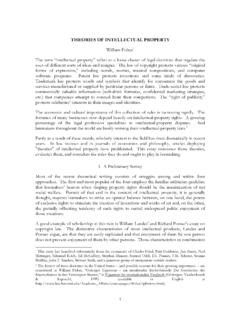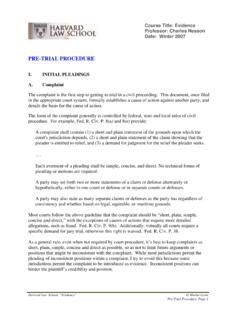Transcription of WAL-MART STORES, INC. v. SAMARA BROTHERS, INC.
1 1 WAL-MART stores , INC. v. SAMARA BROTHERS, INC. 529 205 (2000) Justice Scalia delivered the opinion of the Court. In this case, we decide under what circumstances a product s design is distinctive, and therefore protectible, in an action for infringement of unregistered trade dress under 43(a) of the Trademark Act of 1946 (Lanham Act), 60 Stat. 441, as amended, 15 1125(a). I Respondent SAMARA Brothers, Inc., designs and manufactures children s clothing. Its primary product is a line of spring/summer one-piece seersucker outfits decorated with appliqu s of hearts, flowers, fruits, and the like.
2 A number of chain stores , including JCPenney, sell this line of clothing under contract with SAMARA . Petitioner WAL-MART stores , Inc., is one of the nation s best known retailers, selling among other things children s clothing. In 1995, WAL-MART contracted with one of its suppliers, Judy-Philippine, Inc., to manufacture a line of children s outfits for sale in the 1996 spring/summer season. WAL-MART sent Judy-Philippine photographs of a number of garments from SAMARA s line, on which Judy-Philippine s garments were to be based; Judy-Philippine duly copied, with only minor modifications, 16 of SAMARA s garments, many of which contained copyrighted elements.
3 In 1996, WAL-MART briskly sold the so-called knockoffs, generating more than $ million in gross profits. In June 1996, a buyer for JCPenney called a representative at SAMARA to complain that she had seen SAMARA garments on sale at WAL-MART for a lower price than JCPenney was allowed to charge under its contract with SAMARA . The SAMARA representative told the buyer that SAMARA did not supply its clothing to WAL-MART . Their suspicions aroused, however, SAMARA officials launched an investigation, which disclosed that WAL-MART and several other major retailers Kmart, Caldor, Hills, and Goody s were selling the knockoffs of SAMARA s outfits produced by Judy-Philippine.
4 After sending cease-and-desist letters, SAMARA brought this action in the United States District Court for the Southern District of New York against WAL-MART , Judy-Philippine, Kmart, Caldor, Hills, and Goody s for copyright infringement under federal law, consumer fraud and unfair competition under New York law, and most relevant for our purposes infringement of unregistered trade dress under 43(a) of the Lanham Act, 15 1125(a). All of the defendants except WAL-MART settled before trial. After a weeklong trial, the jury found in favor of SAMARA on all of its claims.
5 WAL-MART then renewed a motion for judgment as a matter of law, claiming, inter alia, that there was insufficient evidence to support a conclusion that SAMARA s clothing designs could be legally protected as distinctive trade dress for purposes of 43(a). The District Court denied the motion, 969 F. Supp. 895 (SDNY 1997), and awarded SAMARA damages, interest, costs, and fees totaling almost $ million, together with injunctive relief. The Second Circuit affirmed the denial of the motion for judgment as a matter of law, and we granted certiorari.
6 2 II The Lanham Act provides for the registration of trademarks, which it defines in 45 to include any word, name, symbol, or device, or any combination thereof [used or intended to be used] to identify and distinguish [a producer s] goods .. from those manufactured or sold by others and to indicate the source of the goods .. 15 1127. Registration of a mark under 2 of the Act, 15 1052 enables the owner to sue an infringer under 32, 15 1114; it also entitles the owner to a presumption that its mark is valid, see 7(b), 15 1057(b), and ordinarily renders the registered mark incontestable after five years of continuous use, see 15, 15 1065.
7 In addition to protecting registered marks, the Lanham Act, in 43(a), gives a producer a cause of action for the use by any person of any word, term, name, symbol, or device, or any combination thereof .. which .. is likely to cause confusion .. as to the origin, sponsorship, or approval of his or her goods .. 15 1125(a). It is the latter provision that is at issue in this case. The breadth of the definition of marks registrable under 2, and of the confusion-producing elements recited as actionable by 43(a), has been held to embrace not just word marks, such as Nike, and symbol marks, such as Nike s swoosh symbol, but also trade dress a category that originally included only the packaging, or dressing, of a product, but in recent years has been expanded by many courts of appeals to encompass the design of a product.
8 See, , Ashley Furniture Industries, Inc. v. Sangiacomo N. A., Ltd., 187 363 (CA4 1999) (bedroom furniture); Knitwaves, Inc. v. Lollytogs, Ltd., 71 996 (CA2 1995) (sweaters); Stuart Hall Co., Inc. v. Ampad Corp., 51 780 (CA8 1995) (notebooks). These courts have assumed, often without discussion, that trade dress constitutes a symbol or device for purposes of the relevant sections, and we conclude likewise. Since human beings might use as a symbol or device almost anything at all that is capable of carrying meaning, this language, read literally, is not restrictive.
9 Qualitex Co. v. Jacobson Products Co., 514 159, 162 (1995). This reading of 2 and 43(a) is buttressed by a recently added subsection of 43(a), 43(a)(3), which refers specifically to civil action[s] for trade dress infringement under this chapter for trade dress not registered on the principal register. 15 A. 1125(a)(3) (Oct. 1999 Supp.). The text of 43(a) provides little guidance as to the circumstances under which unregistered trade dress may be protected. It does require that a producer show that the allegedly infringing feature is not functional, see 43(a)(3), and is likely to cause confusion with the product for which protection is sought, see 43(a)(1)(A), 15 1125(a)(1)(A).
10 Nothing in 43(a) explicitly requires a producer to show that its trade dress is distinctive, but courts have universally imposed that requirement, since without distinctiveness the trade dress would not cause confusion .. as to the origin, sponsorship, or approval of [the] goods, as the section requires. Distinctiveness is, moreover, an explicit prerequisite for registration of trade dress under 2, and the general principles qualifying a mark for registration under 2 of the Lanham Act are for the most part applicable in determining whether an unregistered mark is entitled to protection under 43(a).
















